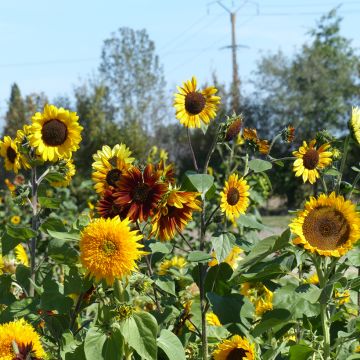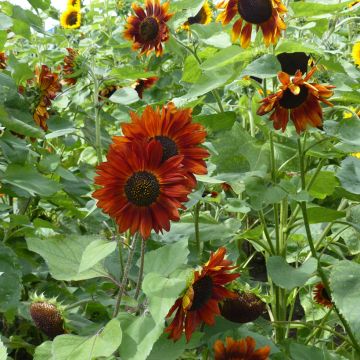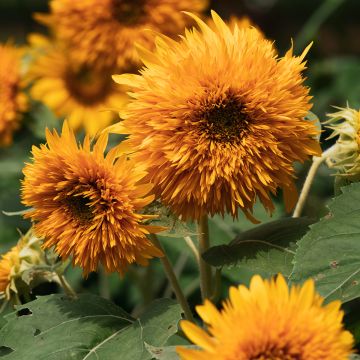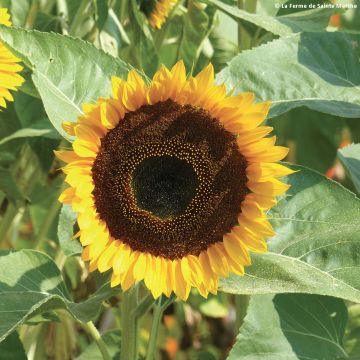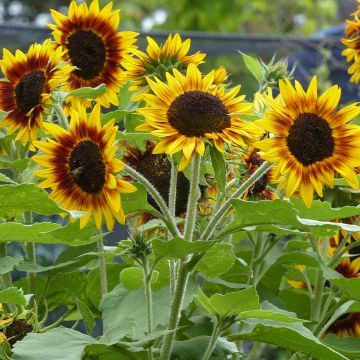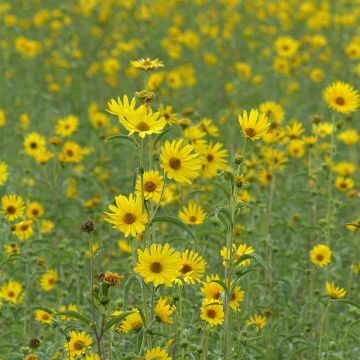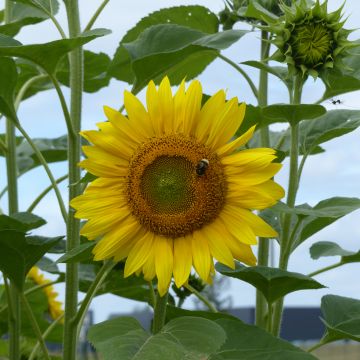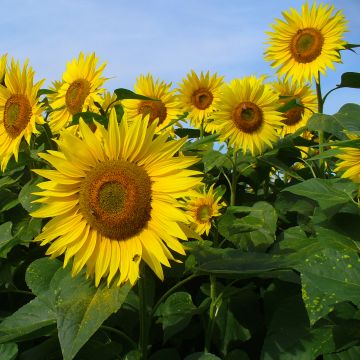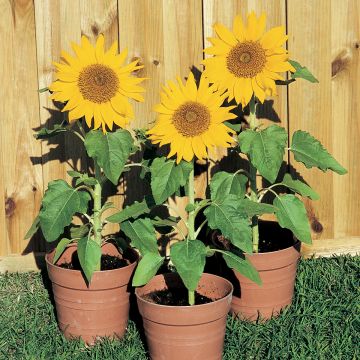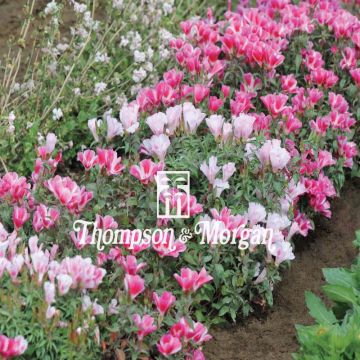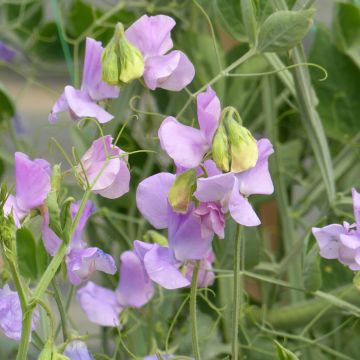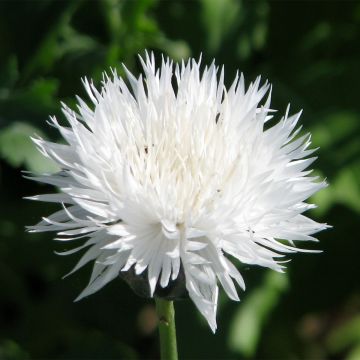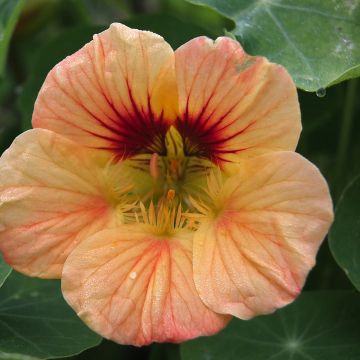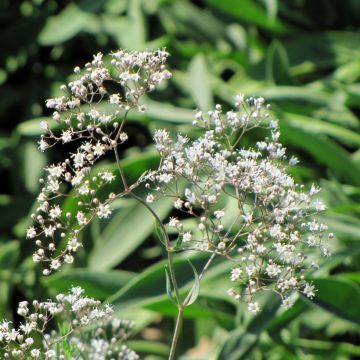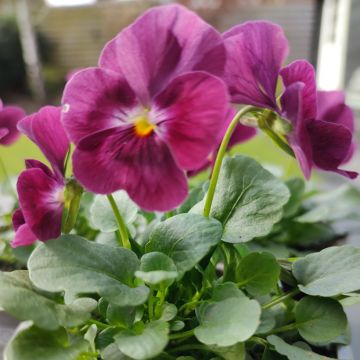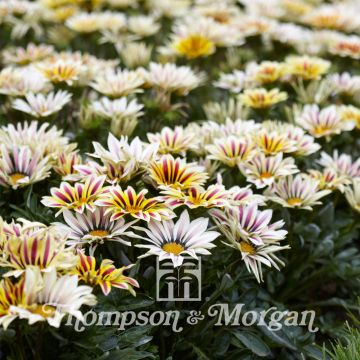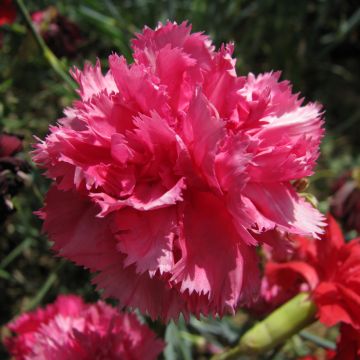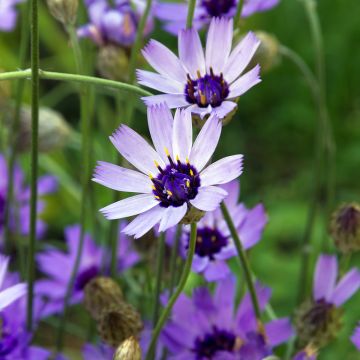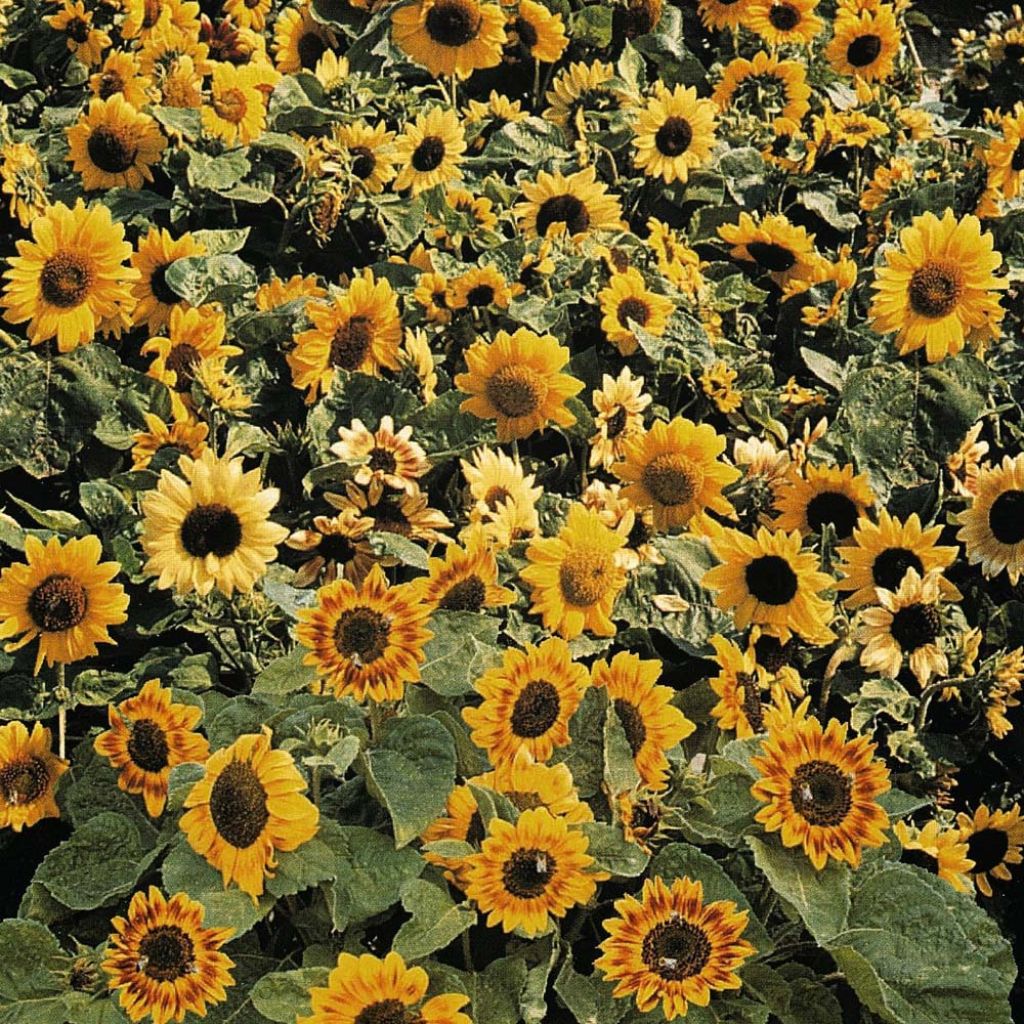

Graines de Tournesol Music Box - Helianthus annuus.
Sunflower Music Box seeds - Helianthus annuus
Helianthus annuus Music Box
Sunflower, Common Sunflower
This item cannot be shipped to the selected country
Dispatch by letter from €3.90
Delivery to Corse prohibited
More information
Schedule delivery date,
and select date in basket
This plant carries a 6 months recovery warranty
More information
We guarantee the quality of our plants for a full growing cycle, and will replace at our expense any plant that fails to recover under normal climatic and planting conditions.
Seed-only orders are dispatched by sealed envelope. The delivery charge for seed-only orders is €3.90.
Delivery to Corse prohibited: UE law prohibits the import of this plant from mainland France to Corse as part of the fight against Xylella fastidiosa. Please accept our sincere apologies.
More information
Does this plant fit my garden?
Set up your Plantfit profile →
Description
Helianthus annuus 'Music Box', or Dwarf Sunflower, brings together plants with very varied flowers, in a symphony of vibrant colours offering a whole range of splendid shades, ranging from cream-white to mahogany, including some beautiful bicoloured flowers. Their modest size is also an asset in sunny borders, flower beds, and decorative pots that will adorn the terrace. These fast-growing annual plants are very easy to succeed in the sun and will thrive in any fertile and well-prepared soil.
Helianthus annuus is none other than the famous sunflower grown on a large scale for the oil extracted from its seeds. This large annual plant from the Asteraceae family has been domesticated for a long time by humans and has a controversial origin, but it is known to be native to the American continent. The 'Music Box' selection produces plants that do not exceed 65cm (26in) in height and have a spread of 30 to 40cm (12 to 16in). It is also distinguished by its highly coloured inflorescences, in 11cm (4in) diameter heads, of solid or bicoloured forms, with a brown centre. Its flowering period extends from July to September, and its very fast growth is an asset for latecomers! Under the best conditions, there are 12 weeks between sowing and the start of flowering. The floral stems are very strong and sparsely branched, adorned with medium green leaves that are simple, cordate (heart-shaped), alternate, except at the base where they are sometimes opposite. They are joined to the stem by a more or less long petiole and have a rough touch.
Its ease of cultivation, its large easy-to-germinate seeds, and its small adult size are very popular with children who are introduced to the joys of gardening. The 'Music Box' Sunflower is enchanting when planted in low flower beds, borders, sunny rockeries, or large pots. It is also welcome near a swimming pool or in front of a grove of trees, as it surprisingly tolerates partial shade very well. It only requires a bit of sun and soil that is not too dry to thrive effortlessly.
Before flowering, the plant optimizes its growth by following the path of the sun. This phenomenon, called heliotropism, has given rise to some of its common names: Héliotrope, Sunflower, Soleil des jardins.
Sunflower in the kitchen:
The buds, petals, and seeds are edible. Add a few petals to a green salad for the contrast of colours and their nutty taste. The green buds can be blanched and then sautéed in garlic butter. Their flavour is similar to that of Jerusalem artichokes. The flesh of the seed can be eaten raw or roasted.
An ecological asset:
Throughout the summer, the nectar-rich flowers of Sunflowers attract pollinating insects and butterflies to your garden. It's a good way to improve the ecosystem of your garden and promote the production of fruits and vegetables in your vegetable garden.
The oil-rich seeds are particularly appreciated by birds (Parrots, Tits, etc.). At the end of flowering, harvest them to make some happy during the winter scarcity.
Report an error about the product description
Sunflower Music Box seeds - Helianthus annuus in pictures
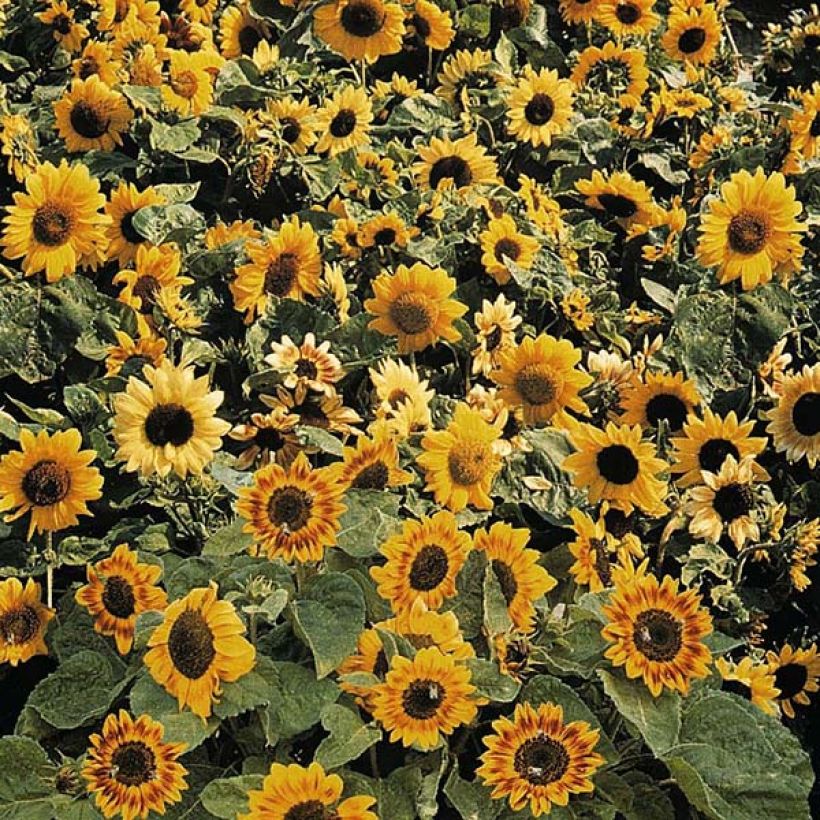

Flowering
Foliage
Plant habit
Botanical data
Helianthus
annuus
Music Box
Asteraceae
Sunflower, Common Sunflower
Cultivar or hybrid
Other Sunflower seeds
Planting and care
Sow the Sunflower 'Music Box' from March to May in pots. Use high-quality soil that you will sift on the surface to bind the seed to its substrate. Before sowing, lightly press the soil with a plank. Sow your seeds by broadcasting. Cover the seeds by sprinkling soil on top or vermiculite, lightly press and water generously with a fine rain. Place your pots in light, without direct sunlight, at a temperature of 20°C (68°F) to 25°C (77°F). Lower the temperature at night to 17°C (62.6°F) to create a beneficial alternation for germination.
The seeds will take 21 days to germinate. Keep the soil moist but not excessive during growth. 15 days before their final placement, start gradually acclimatizing them to a temperature of 15°C (59°F).
By late May or early June, the temperature in the garden will be warm enough to plant your young plants. Choose a sunny location. Add a good shovelful of compost to each planting hole. Space your plants 45 to 60cm (18 to 24in) apart.
Seeds sown in May can be directly sown in place. By staggering your sowings, you will extend the flowering season until autumn.
Protect your seedlings from attacks by snails and slugs, which are fond of these young plants. By sowing chives near your sunflowers, you will deter aphids from settling there.
Sowing period
Intended location
This item has not been reviewed yet - be the first to leave a review about it.
Flower seeds
Haven't found what you were looking for?
Hardiness is the lowest winter temperature a plant can endure without suffering serious damage or even dying. However, hardiness is affected by location (a sheltered area, such as a patio), protection (winter cover) and soil type (hardiness is improved by well-drained soil).

Photo Sharing Terms & Conditions
In order to encourage gardeners to interact and share their experiences, Promesse de fleurs offers various media enabling content to be uploaded onto its Site - in particular via the ‘Photo sharing’ module.
The User agrees to refrain from:
- Posting any content that is illegal, prejudicial, insulting, racist, inciteful to hatred, revisionist, contrary to public decency, that infringes on privacy or on the privacy rights of third parties, in particular the publicity rights of persons and goods, intellectual property rights, or the right to privacy.
- Submitting content on behalf of a third party;
- Impersonate the identity of a third party and/or publish any personal information about a third party;
In general, the User undertakes to refrain from any unethical behaviour.
All Content (in particular text, comments, files, images, photos, videos, creative works, etc.), which may be subject to property or intellectual property rights, image or other private rights, shall remain the property of the User, subject to the limited rights granted by the terms of the licence granted by Promesse de fleurs as stated below. Users are at liberty to publish or not to publish such Content on the Site, notably via the ‘Photo Sharing’ facility, and accept that this Content shall be made public and freely accessible, notably on the Internet.
Users further acknowledge, undertake to have ,and guarantee that they hold all necessary rights and permissions to publish such material on the Site, in particular with regard to the legislation in force pertaining to any privacy, property, intellectual property, image, or contractual rights, or rights of any other nature. By publishing such Content on the Site, Users acknowledge accepting full liability as publishers of the Content within the meaning of the law, and grant Promesse de fleurs, free of charge, an inclusive, worldwide licence for the said Content for the entire duration of its publication, including all reproduction, representation, up/downloading, displaying, performing, transmission, and storage rights.
Users also grant permission for their name to be linked to the Content and accept that this link may not always be made available.
By engaging in posting material, Users consent to their Content becoming automatically accessible on the Internet, in particular on other sites and/or blogs and/or web pages of the Promesse de fleurs site, including in particular social pages and the Promesse de fleurs catalogue.
Users may secure the removal of entrusted content free of charge by issuing a simple request via our contact form.
The flowering period indicated on our website applies to countries and regions located in USDA zone 8 (France, the United Kingdom, Ireland, the Netherlands, etc.)
It will vary according to where you live:
- In zones 9 to 10 (Italy, Spain, Greece, etc.), flowering will occur about 2 to 4 weeks earlier.
- In zones 6 to 7 (Germany, Poland, Slovenia, and lower mountainous regions), flowering will be delayed by 2 to 3 weeks.
- In zone 5 (Central Europe, Scandinavia), blooming will be delayed by 3 to 5 weeks.
In temperate climates, pruning of spring-flowering shrubs (forsythia, spireas, etc.) should be done just after flowering.
Pruning of summer-flowering shrubs (Indian Lilac, Perovskia, etc.) can be done in winter or spring.
In cold regions as well as with frost-sensitive plants, avoid pruning too early when severe frosts may still occur.
The planting period indicated on our website applies to countries and regions located in USDA zone 8 (France, United Kingdom, Ireland, Netherlands).
It will vary according to where you live:
- In Mediterranean zones (Marseille, Madrid, Milan, etc.), autumn and winter are the best planting periods.
- In continental zones (Strasbourg, Munich, Vienna, etc.), delay planting by 2 to 3 weeks in spring and bring it forward by 2 to 4 weeks in autumn.
- In mountainous regions (the Alps, Pyrenees, Carpathians, etc.), it is best to plant in late spring (May-June) or late summer (August-September).
The harvesting period indicated on our website applies to countries and regions in USDA zone 8 (France, England, Ireland, the Netherlands).
In colder areas (Scandinavia, Poland, Austria...) fruit and vegetable harvests are likely to be delayed by 3-4 weeks.
In warmer areas (Italy, Spain, Greece, etc.), harvesting will probably take place earlier, depending on weather conditions.
The sowing periods indicated on our website apply to countries and regions within USDA Zone 8 (France, UK, Ireland, Netherlands).
In colder areas (Scandinavia, Poland, Austria...), delay any outdoor sowing by 3-4 weeks, or sow under glass.
In warmer climes (Italy, Spain, Greece, etc.), bring outdoor sowing forward by a few weeks.

































